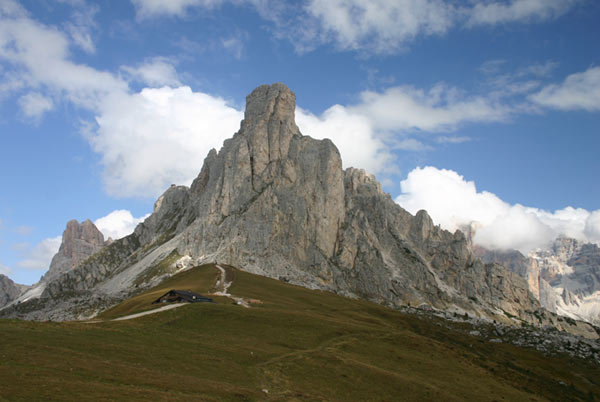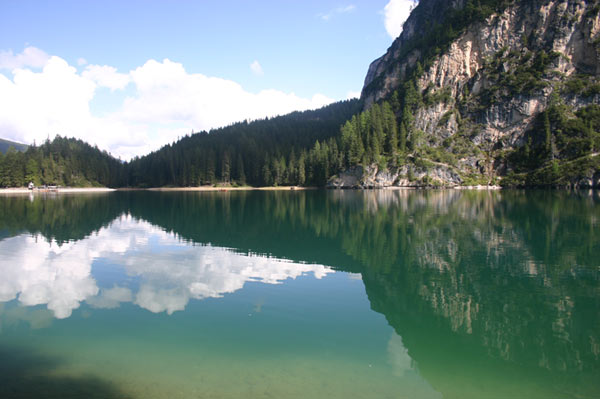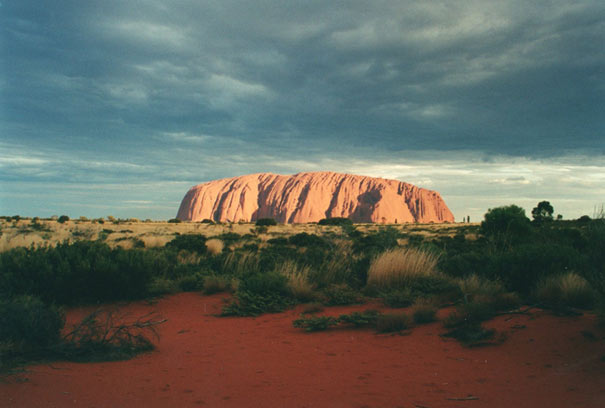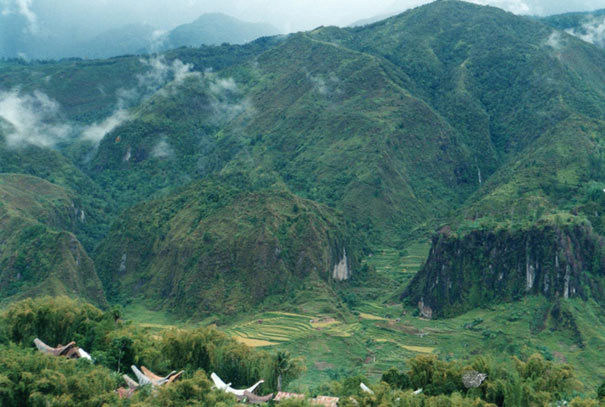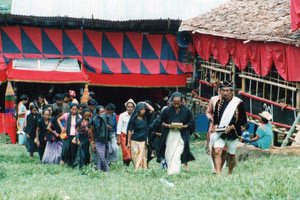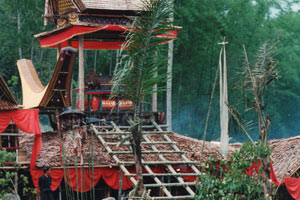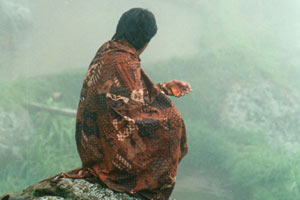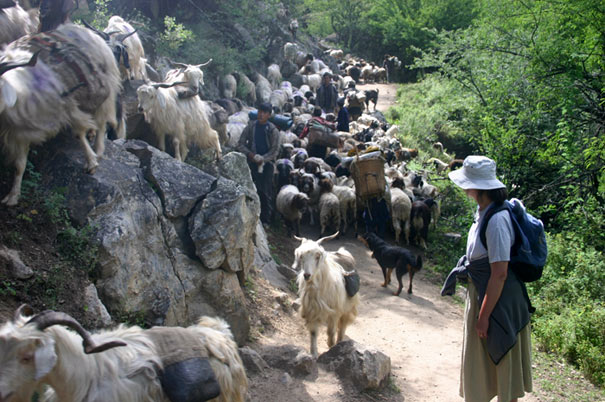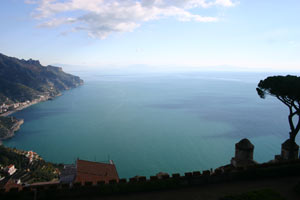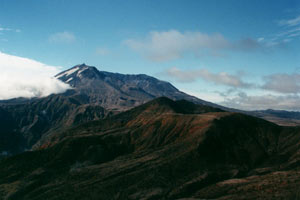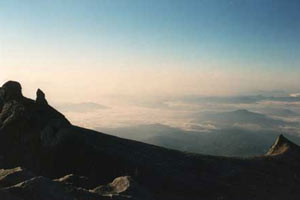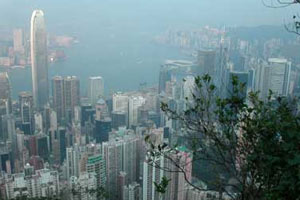|
|
|

We hope you find it inspiring and fun.
Let us know what you think and do tell a friend by forwarding this magazine to them.
If you would like to receive future editions, register here (it is easy). Coming up:
- Mount Kinabalu, Borneo
- Hadrian’s Wall
- Mount Athos, Greece

|
Alta Via 1, Dolomites, Italy
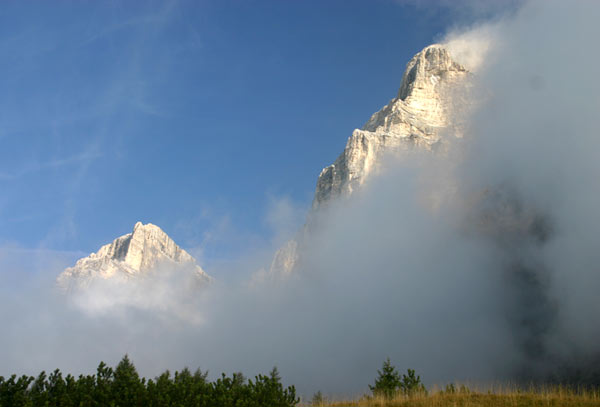 |
Pelmo through clearing mist
|
The Dolomites are, in Walkopedia's opinion, Europe 's most thrilling mountains, arguably it's most beautiful and certainly it's most outlandish. The area is riddled with outstanding walks, but the Alte Vie are recognized Crown Jewels.
Everyone has seen pictures of the Dolomites, but the reality will always exceed your expectations. The vast limestone towers that soar, thousands of feet above the surrounding scree and high meadows, with beautiful, often virgin, mixed forest on the lower slopes, evoke the grandest serene majesty. They are not as high as the tallest Alps, but outdo all but the greatest - the Mattterhorn, the Eiger and the like - for sheer drama.
The Alte Vie routes are brilliantly chosen, winding across high stony plateaus and meadows, under an ever-changing backdrop of cliffs and soaring massifs.
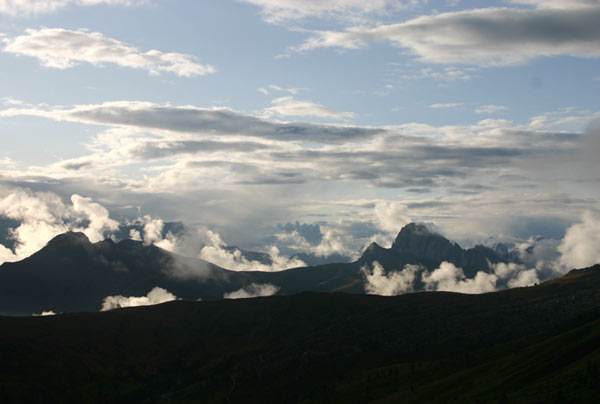 |
Evening light from Passo Giau
|
Alta Via No.1 begins at the immaculately pretty Lago di Braes, above the wide valley that separates the Dolomites from the Alps. After briefly rounding the lake, it turns south and climbs steeply into the highlands, taking in the First World War battlefield below the enormous Le Tofane, cresting the high Nuvolau with its tear-inducingly beautiful 360° views, and circuiting the huge towers of the Pelmo mass.
For us, the highlights were:
- Descending the narrow gully, between huge, smooth cliffs, from the Forcella del Lago, an extraordinary little gap in a long, soaring spine, to the beautiful little Lago di Lagazuoi (the view back across the lake, partly obscured by shreds of poetic Chinese mist, was especially beautiful).
- The World War I relics around the base of Le Tofane and the subsequent traverse below that massif, with (on a good day) its extraordinary views.
- The gut-wrenchingly exposed but wildly exhilarating via ferrata (cable and ladder assisted) descents from the Nuvolau ridge.
- The ascent round the desolately magnificent bowl of broken boulders and snow of the Val d'Arcia and the subsequent descent down a vertiginous shale slope and via ferrata Pelmo cliff traverse on the Sentiero Flaibani (Tip: if a route has a name, it is likely to scare you into nightmares that night). Amazing.
The via ferrata sections involve real risk (don't try them in bad weather and make sure you are suitably equipped) and are probably a thrilling challenge for the minority of walkers, terrifying for the rest. There are good alternatives to all via ferrata sections.
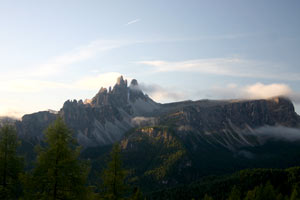 |
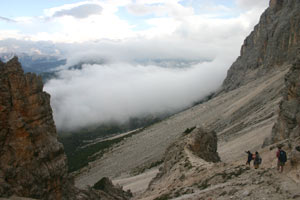 |
|
Descending from the Pelmo cliffs
|
A glory of Alta Via 1 is its regular refuges, all simple but comfortable and providing food, with some at hotel standards. Many have outstanding views. You can, as a result, walk for days with a medium weight pack only.
The Dolomites enjoy a rich plant and animal life – you will be delighted by the bright alpine flowers you will see throughout the walking season. The forests are a mixture of pine and deciduous trees. You are likely to see marmots and may see chamoix. Eagles, white partridges, choughs and capercaille are about.
Not many people have the time to walk the whole 150km of the Alta Via, but, with frequent access and exit points, creating a route to suit your time and inclination is not difficult. Day walks are very possible.
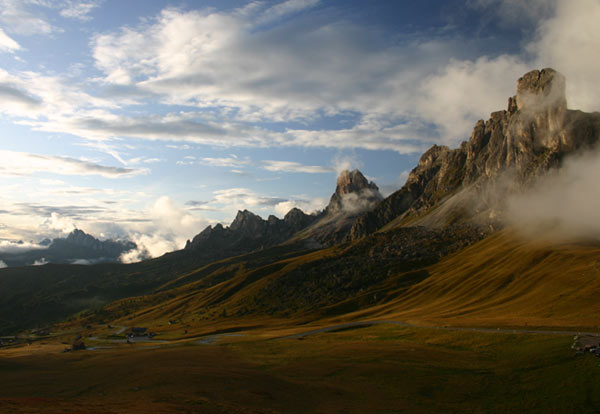 |
Nuvolau group from Passo Giau
|
|
|
|
Icon: Stormy sunset, Uluru (Ayres Rock)
|
|
|
Walkopedia favourite: Torajaland, Sulawesi, Indonesia
High in the remote central mountains of the spice island of Sulawesi, a remarkable culture has survived with its traditions and graceful, boat-like wooden houses and granaries virtually intact.
This obscure area of animists and head hunters was never absorbed into the spreading Muslim world, eventually falling to Christian domination in the late 1880s. The locals have created a fascinating fusion of these traditions, with the funerals of bigwigs lasting for days amid Homeric scenes of fire and feast as people gather from miles around with pigs and buffalo for the slaughter. Funerals can be held years after the death, and cost the family dear. Other festivals – bull fighting (between buffalos, with little or no lasting damage) or the celebration of completing a new house, perhaps – are absolutely not to be missed, as is the weekly market at Rantepao, the main town.
The old style of building is still much in evidence; highly decorated houses and granaries built on stilts, with unique swooping roofs that are reminiscent of sailing craft. Their panelled little rooms are reminiscent of antique sailing ships’ cabins.
Immaculate rice terraces cling to the surrounding hillsides. In the valleys, water buffalo churn up the paddies, women totter under poles carrying rice seedlings and grannies sit on steps of houses watching the children play in the dirt. A group may be huddled around a cockfight.
The valleys wind between karst outcrops where, on high ledges and in caves, the effigies of their ancestors stare implacably across the verdant paddy fields.
As you climb to the highlands, you will trudge up tracks between fantastic rice terraces, an extraordinary memorial to generations on generations of back-breaking toil. You gain huge views of whole hillsides of terraces topped by ridges of thick jungle.
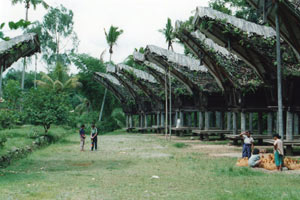 |
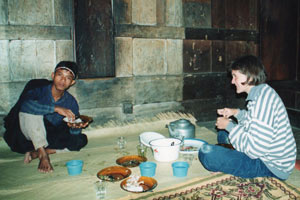 |
|
Supper in a traditional house
|
The upland villages are particularly intact, both physically and culturally. On one memorable evening, we sat in the grubby village "square" watching cockfights (again, not lethal, for the squeamish) with what seemed like the whole population shouting encouragement. We then slept in a panelled room in the all-wooden stilted house - it felt like a cabin in a Napoleonic warship, albeit perhaps more sparsely furnished. Amazing.
You can walk through rice fields and timeless villages in the valleys, or take to the hills, crossing the jungle - smothered ridges from valley to perfect valley. Walks vary from straightforward day walks from hotels in the valleys; or tougher overnight treks, staying in old wooden houses in high, remote villages.
You need to spend several days here, with at least one day walking in the main valleys and two - including an overnight stop in an upland village – in the high country. Your choice of guide will be vital, and check what festivals are on before your make any arrangements.
This is steamy country, with frequent showers, so you will often enjoy the misty aftermath of the downpour you just endured.
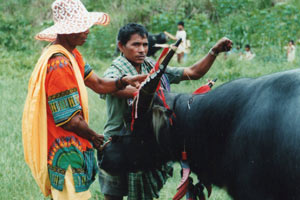 |
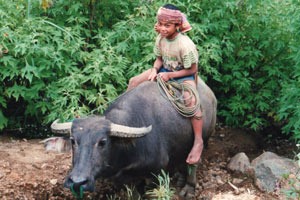 |
Preparing a fighting bull
|
|
Our walks had some extraordinary highlights.
- The almost painfully verdant beauty of the lower valleys, with their lovingly tilled rice fields dotted with comfortable looking villages.
- A buffalo fighting festival; a housewarming (with a priest conducting a ceremony surrounded by more trussed-up pigs than people); and a vividly memorable funeral, with a square of temporary shelters housing brightly dressed visitors who had walked there from miles around, while mass slaughter was being done outside, the ground by mid-afternoon as slippery with blood as a Roman amphitheatre. Behind the scenes, the entrails of dismembered carcasses emitted a torrent of writhing parasites.
- The beauty of a deep mist-wreathed valley from a ridge high above, where steep rice terraces pushed up to the jungly gulleys between the cracked limestone cliffs.
- Crossing a jungle ridge, the path descending through thick forest, past rushing streams, into a deep valley with impossible rice terraces.
- A man sitting on a rock amid watery rice terraces, the next morning, huddled in his bright blanket against the cold, rising clouds.
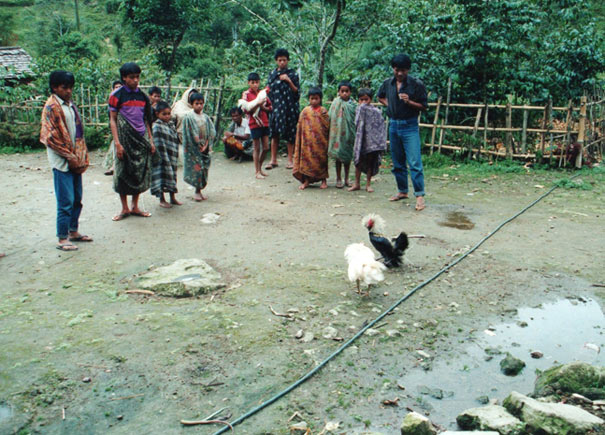 |
|
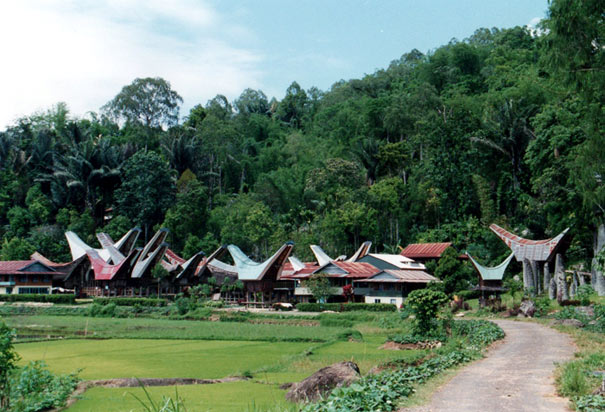 |
Village in the main, steles to right valley
|
|
|
|
En Passant: pack goat traffic jam, Upper Humla Valley, Nepal
|
|
|
The Reluctant Walker: Serena Mackesy on how your children can enjoy walking
In a previous edition, we covered the best ways to put your children off walking as a pastime. This time: ways to give them (and yourself, of course) a good start.
I really didn’t walk much at all (beyond a period of introspective night-time wandering along the ruinous banks of the pre-regeneration Thames during my second adolescence in the early 90s) between swearing I would never do so again at around the age when I got to choose my own holidays and, essentially, being tricked into doing it again by an editor who thought that Fat Chick on Fitness Holiday would make a hilarious piece. It’s something I regret now, but, as a youngest child, my memories of our holidays on the Celtic fringes mostly consist of trying to keep up and wishing they’d let me go pony-trekking. I know now that even a sedentary writer can get a lot of pleasure from the occasional trip to the hills, but my first reaction whenever a walk is suggested is still to feel a slight quail of dread: it’s hard-wired into me and I have to overcome it every time.
If you love walking yourself, and want to pass that love on down to the next generation, it’s worth thinking about how best to approach sneaking a bit of pleasant anticipation into their experience, the way you sneak vegetables into their meals. You know it’s good for them: but the easiest way to establish that behaviour as routine is to help them like it in the first place. Here are some tips to help you along:
- Proper planning is the key. Actually researching your route – its true length in terms of taxingness (gradient makes a big difference, ergonomically), shortcuts off in case of energy failure – will really pay dividends. To calculate how far is reasonable, estimate how far your child can walk, and subtract 25%: like a good old showbiz trouper, you should know that it’s always best to leave ’em wanting more.
- Start them off gently. Yes, you may be raring to get out there among those Cairngorms after years of pushchairs, but if you want them to catch your own enthusiasm, make sure that they’re never so tired that they can’t see the rewards of doing the work. You will do yourself far more favours, long-term, if you start off with a handful of two-mile walks and gradually add a mile or so at a time. Remember: people who throw themselves into the gym for intensive workouts on January 2nd are far less likely to still be doing it come March than the ones who just start off by walking rather than catching the bus.
- And while we’re on that subject: if, like most people, your family walks in sporadic holiday bursts, don’t expect to just start the next holiday at the distance you achieved at the end of the last. Kids’ fitness and stamina levels drop just like adults’. Even better, of course, is to make going for a decent length of walk somewhere new such a completely routine thing in their day-to-day lives that it never occurs to them to question why they would want to do it on holiday.
- Make sure they have proper footgear: they’ll forgive fashion crimes once on the move.
- Circular walks, if you can manage to find them, are a really, really good idea. It’s so much easier to keep someone going forward if there’s always new stuff to see – and even easier if you can tell them that it’ll take longer to retrace their steps.
- Similarly, it’s a good idea to research your route well enough that you can pick out landmarks on a fairly regular basis. Not only does this make it easier to give clear and truthful responses to the “are we nearly there yet?” question, but getting the young to look out for them can be a very useful diversionary tactic. And you never know, it might also help them learn to notice that there’s a world beyond McDonalds and their own immediate gratification.
- Be generous with map time. I always loved them when I was a kid and was never given enough time to look at them. Once they can understand maps even quite sketchily, let them see the route before you set out, and let them see it along the way. Reading them, actually in context, and working out where you are and where you’re going and what it might look like, gives a lot of similar gratification to doing a really good cryptic crossword. It also gives the young some illusion of greater control than they actually have – which is always a good thing. And, particularly given how indifferently Geography is taught in many schools, it’s no bad thing to slip in a bit of education in the guise of entertainment along the way.
- While being tired after a good day’s exercise can be pleasurable, do remember that complete exhaustion is anything but. Especially if, as is the case with children, you can also feel that it’s a state someone else chose to put you in.
- For every hour that you would normally expect a route to take, add another thirty minutes for poking animal carcases with sticks, paddling, peering into unexceptional caves, chasing sheep and so forth. These things are just as stimulating to the young as covering distance, and a walking memory populated with discoveries will reward you later in terms of enthusiasm for more.
- On the same subject: children don’t have your refined and poetic appreciation of views and landscape. They like things – a lake, a ruin, a beach – far more than they care about being able to see for miles and miles, or not sharing the landscape with another living soul. Plan walks around a fun goal like a castle or a cave or a waterfall or a swim, and allow a good lump of time for them really enjoy it before you set off for home again.
- For God’s sake let them take rests. Seriously. Children’s powers of recovery are pretty miraculous, but if you don’t let them kick in, you’ll have to turn back much sooner. And don’t badger them with timed rests, either. It’s pretty easy to tell when they’re ready for the off – just wait for them to start arguing.
- For small ones, you’ll be surprised to discover how much ground you can cover while playing Grandmother’s footsteps. Especially if Grandmother keeps walking a few yards further on (something kids do naturally) every time she turns round and catches people. And if the stalkers are encouraged to run to catch Granny out.
- Don’t forget that tiredness, headaches and general grumpiness are also symptoms of dehydration – and that children can be really thick when it comes to remembering to drink off their own bat. On any walk over a mile, give them their own water bottle and check that they use it.
- If all else fails, try bribery. Kendal Mint Cake got me up a Brecon Beacon. Always bear in mind, though, that sugar rush is always followed in short order by sugar crash, and be prepared.
Serena Mackesy is a novelist, journalist and travel writer. Her latest novel, Hold My Hand, is published by Constable, and can be found at www.amazon.co.uk.
|
|
|
Walking interludes
You may be in an area only briefly. Here are some unmissable walks, all a day or less.
Around Ravello, Italy
Wonderful views of the exquisite Amalfi coast from this ancient town and the hillside below it. |
|
Mt. St. Helens, USA
Witness the aftermath of the cataclysmic 1980 explosion of this famous volcano. |
|
|
|
|
|
|
|
|
|
New on Walkopedia website:
|
| |
Walk of the month: |
|
Latest walk: |
| |
Mt Kinabalu, Sabah, Malaysia
|
|
The Peak, Hong Kong, China
|
| |
|
|
|
| |
- The massive granite precipices of 4,095m Mount Kinabalu rise clear of the steamy Sabah Jungle. This is one huge, awe-inspiring volcanic plug.
- Ascend through beautiful cloud forest, emerging onto the smooth, steep rock of the upper slopes.
- The next morning, see the mountain's shadow recede into eternity on the clouds below, and enjoy the silhouetted fantastical formations as the sun rises; peer into the upper reaches of the deadly Lows Gully.
- A tough climb, gaining some 2,500m in less than 24 hours: you will feel the altitude.
|
|
- Hong Kong's most famous views, from its most famous mountain.
- Wander along paths and surprisingly quiet roads through beautiful woodland, never far from outstanding views across extraordinary Hong Kong harbour or south to Lamma Island slumbering in the hazy south China sea.
- Gripping contrasts between one of the most densely populated places on earth, the sheer, thickly forested mountainsides and the beauty of the seascapes.
- Very crowded near the Peak Tower and around Victoria Peak, surprisingly quiet elsewhere.
Read More ...
|
| |
Number of walks featured in Walkopedia: 338.
|
|
|
|
|
 |
|







